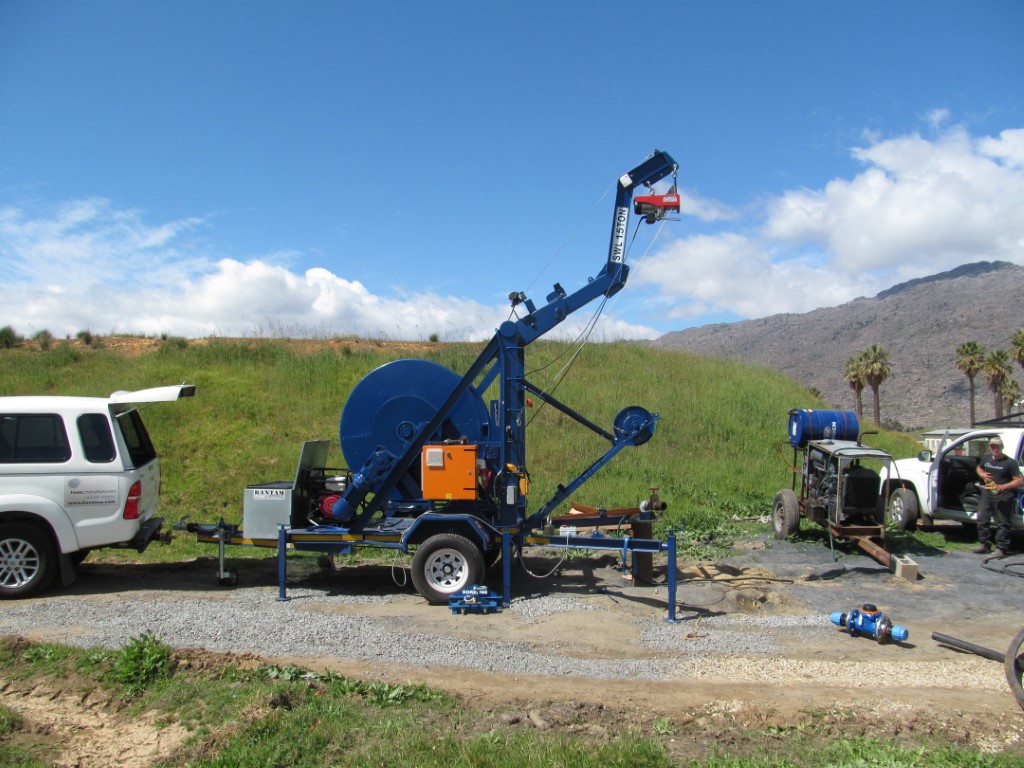It is essential to have the yield of a borehole tested for numerous reasons:
- To establish the safe yield of the borehole. (This refers to the yield at which the borehole can safely be pumped).
- To determine the safe yield duty period that the borehole can be operated for indefinitely, without endangering the aquifer.
- To determine the quality of the groundwater in relation to its intended use, the performance characteristics of the borehole and the hydraulic parameters of the aquifer.
How long should the test-pumping take?
The length of the pumping test is directly proportioned to the duty period that the borehole is to be pumped at once the permanent pump has been installed.
For instance, a borehole supplying domestic water to a house will have a shorter duty period than an irrigation borehole. As a result, the type and length of the test pumping performed on a domestic borehole will be shorter than the test on an irrigation borehole.
Test Pumping
The test contractor should issue the customer with a certificate upon which the date, depth at which the test pump was installed, static water level, pumping rate at the end of the test and water colour is recorded.
It is normal to undertake a six hour test and then install a pump with a capacity of around 50-60% of the flow at the end of the test. This 40-50% safety margin is sufficient in most cases, but not always. The end user should always consult the pump installer as to exactly what type of test is the best for his needs.
Greater sophistication and longer water yield tests will cost more. In many cases the extra initial cost can save a great deal of money in the long run. Unless absolutely necessary, never pump the borehole at its full capacity.
Farmers, recreational clubs or commercial or industrial concerns will usually require a higher duty period, and as a result, a longer test. Occasionally the test, for example per 100% duty period, should continue for weeks and even months.
Boreholes to be subjected to a duty period of up to 10 hours per day should be tested for at least 24 hours. Water levels should be recorded at specific time intervals in the pumping borehole, together with the pump discharge for the duration of the test. Water levels (draw-down) should be recorded from the start of the test until the pump is stopped. The recovery of the water level in the borehole should then be recorded until the borehole has recovered to within 10% of the initial static water level.
Boreholes that are to be used every day and must supply a dependable daily water supply, for instance municipal, industrial or irrigation holes, should be test-pumped for longer periods of time. The test pumping should consist of a step draw-down test and a recovery test. This should be followed by a constant discharge test of at least 48 hours and a recovery measurement to within 5% of the original static water level.
Borehole Interference
Should two boreholes be situated close together, it is advisable to record the level in the borehole not being pumped (observation hole) while pumping the other hole. Should the borehole exhibit interference, the water level in the observation hole will decline.
This means that the boreholes are hydraulically connected and pumping from one hole affect the other. Consequently, if the two boreholes are to be pumped simultaneously they will have to be pumped at a rate lower than the tested rate to allow for the interference.
Water Samples
Towards the end of the pumping test a groundwater sample should be taken to determine the quality of the groundwater in terms of its intended use.
The depth of the fracture, along with the safe yield of the borehole and the pressure required by the end user, are the three most important factors that the installer will have to consider on choosing the correct pump for the customer’s needs.
Boreline®
Yield tests are numerous and continuous and require the frequent installation and removal of pumps and pipes. With Boreline®, this process takes no more than a couple of minutes.
Contractors that have used Boreline® agree that the ease and speed of working with this product makes financial sense. The long-life expectancy of Boreline® also ensures years of hassle-free service.
Yield
A much asked questions is whether or not a borehole will always continue to have the same yield. The answer to this is “No”. The water yield can vary depending on the time of the year, the number of new boreholes in the vicinity, the yearly changes in the annual rainfall and the local detrimental effects of increased transpiration as a result of the planting of large numbers of trees.
It is for these reasons that wide safety margins are allowed when installing the correct pumping system. Therefore, unless the borehole very obviously yields far more than the end-user needs and the water has also come clear during the flushing process, always insist on having the safe water yield determined for your borehole. An estimate of the water yield by the driller is not sufficient and can be inaccurate.
If you are lucky enough to have a borehole that yields plenty of water, do not pump more than you need.
Groundwater is a very precious resource and should not be wasted.

